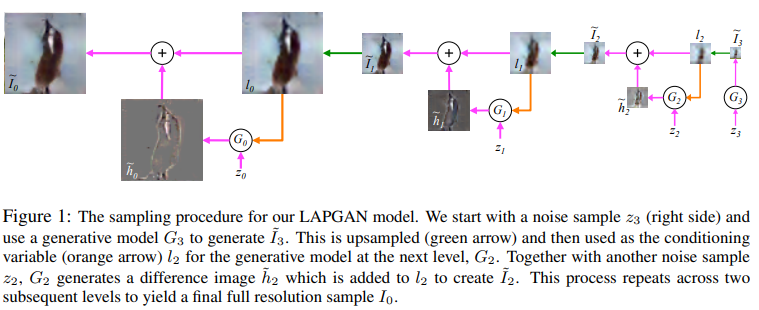High Resolution Image GAN¶
LAPGAN¶
Deep Generative Image Models using a Laplacian Pyramid of Adversarial Networks (NIPS 2015)
aim for high-resolution image via using low-resolution image as condition, similar to residual learning
In this paper we introduce a generative parametric model capable of producing high quality samples of natural images. Our approach uses a cascade of convolutional networks within a Laplacian pyramid framework to generate images in a coarse-to-fine fashion. Note: Could I consider it as GAN plus residual+GAN based super-resolution?
Progressive GAN¶
Progressive Growing of GANs for Improved Quality, Stability, and Variation (ICLR 2018) by Nvidia
Official TensorFlow implementation | PyTorch implenetation (unofficial) | PyTorch/hub
Growing¶
resize + w * conv, increase weighting of convolution to fade smoothly
fully integrate previous learning result into bigger model
Normalization¶
Pixelwise Feature Vector Normalization in generator
Result¶
### Compare with LAPGAN Progressive GAN merge the small model into large model. In inference step, Progressive GAN take features as input, LAPGAN take low-resolution image as inputpix2pixHD (CVPR 2018)¶
High-Resolution Image Synthesis and Semantic Manipulation with Conditional GANs by Nvidia + author of pix2pix
Project
We present a new method for synthesizing high-resolution photo-realistic images from semantic label maps using conditional generative adversarial networks (conditional GANs). Conditional GANs have enabled a variety of applications, but the results are often limited to low-resolution and still far from realistic. In this work, we generate 2048x1024 visually appealing results with a novel adversarial loss, as well as new multi-scale generator and discriminator architectures. Furthermore, we extend our framework to interactive visual manipulation with two additional features. First, we incorporate object instance segmentation information, which enables object manipulations such as removing/adding objects and changing the object category. Second, we propose a method to generate diverse results given the same input, allowing users to edit the object appearance interactively. Human opinion studies demonstrate that our method significantly outperforms existing methods, advancing both the quality and the resolution of deep image synthesis and editing.
Coarse2fine Generator¶
Compare with Progressive GAN¶
- The main idea of both 2 paper is grow the GAN after training low-resolution. Training small generator first, then use a bigger generator include the small generator.
- pix2pixHD is supervised/conditional while Progressive GAN is un-supervised. pix2pixHD have a encoder in generator while Progressive GAN start with latent input.
- pix2pixHD is handle low-resolution image feature as residual. Progressive GAN fade-out the previous small model and let the big model continus learning the weight.
- When inference with final model, pix2pixHD input high resolution input image + resized low resolution input image(s). Progressive GAN input size remain (latent random noise).
BigGAN¶
Large Scale GAN Training for High Fidelity Natural Image Synthesis (ICLR 2019) by DeepMind
TPU advertisement: 512 TPU
PyTorch code |
[P] Want to train your own BigGAN on just 4-8 GPUs? Today we’re releasing BigGAN-PyTorch
high resolution (512x512) output, based on SA-GAN
Not only increase the computation, there are still novel improvement to handle the big GAN.
- Batch size and regularization
- truncation trick: improve quality of output (trade-of diversity)
- why big GAn usually not stable and solutions

